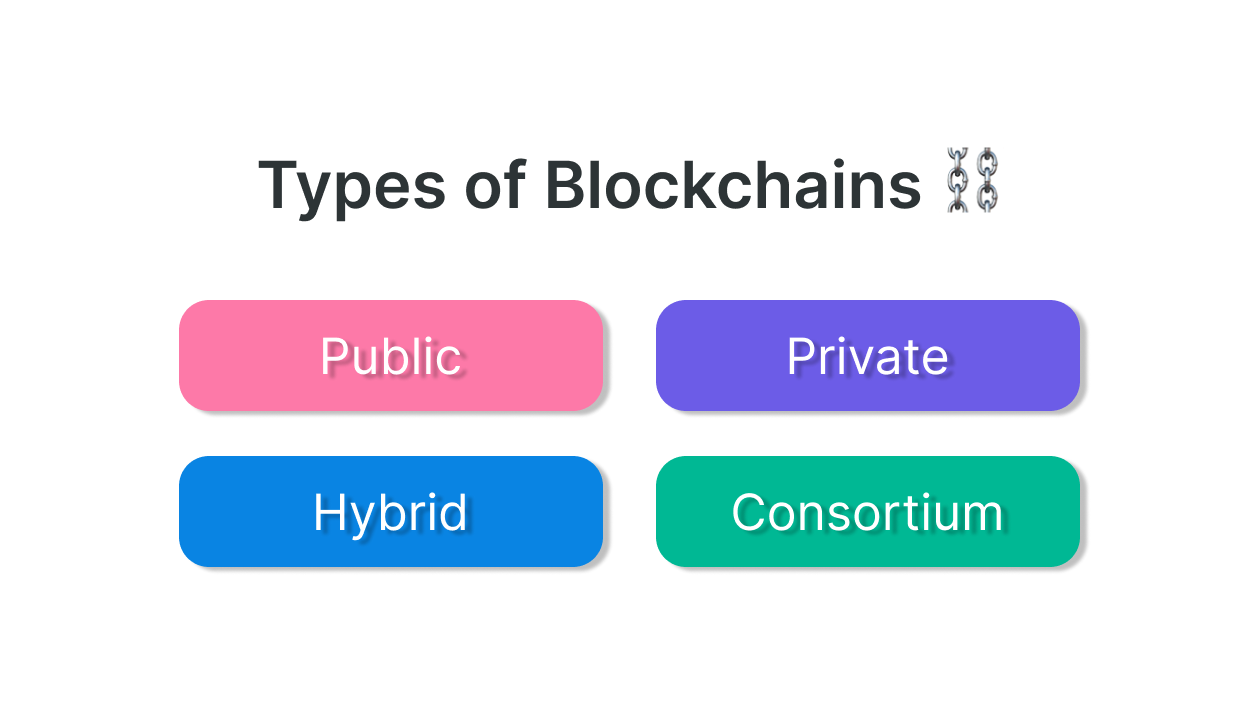Table of Contents
If you’re newly introduced to blockchain, chances are you’ll find yourself wondering how many types of blockchains there are, sooner than later. So far, from what is known, there are 4 types of blockchains around. And we’ll be exploring them below.
But briefly, what is a blockchain?
Blockchain is a public database for storing real-world data, shared and updated with many nodes (computers) across the globe. In technical terms, blockchain is a collection of blocks linked to each other.
The word “blockchain” consists of two parts: block and chain.
“Block” is an entity that stores any real-world data. For our convenience, let’s assume that a block stores the transactions happening on the internet. If Holly sends 5 ETH (Ethers) to Molly, this transaction needs to be added to a block to be successful.
“Chain” can be defined as a cryptographic link of a block with the previous block. In other words, the link between blocks forms a chain of blocks. So, to sum it up, blockchain is a collection of blocks chained together using cryptography.
🔥 Easy tutorial: How to create your own token on Binance
Types of blockchains
So how many types of blockchains are there? First, let’s address why we need different types of blockchains. A simple answer for this is that even though the blockchain technology behind several projects, the necessity to have different blockchains comes in order to target end users.

For instance, private blockchains target and cater to invitation-only users whereas public ones are for the general public as end users.
Here are 4 different types of blockchains:
- Public
- Private
- Hybrid
- Consortium
1) Public blockchain
A public blockchain refers to a distributed ledger system that is permission-less and non-restrictive. So basically, anyone who can access the internet can easily sign in and get on a blockchain platform. Upon doing so they become part of the blockchain’s network and also an authorized node or user.
Authorized nodes or users can mine, access current and past record as well as verify transactions, find bugs and do proof-of-work for an incoming block. Because they can mine, the most common use of public blockchains is for exchanging cryptocurrencies and conducting mining activities.
Examples: Bitcoin and Ethereum
2) Private blockchain
A private blockchain is one that, unlike the former, works in a restrictive environment. This could be a closed network or the blockchain could also be under the control of a single entity, thus they also get the name of permissioned or enterprise blockchains.
Even though it’s decentralized and uses peer-to-peer connections pretty much like a public blockchain, it usually much smaller in scale. A blockchain network that works in a restrictive environment like a closed network, or that is under the control of a single entity, is a private blockchain.
While it operates like a public blockchain network in the sense that it uses peer-to-peer connections and decentralization, this type of blockchain is on a much smaller scale and operates on a small network that is open to only a select group.
Example: HyperLedger and Ripple XRP
👀 How-to: Launch your own epic NFT marketplace
3) Hybrid blockchain
A hybrid blockchain combines the aspects of private and public blockchains i.e. it is permissioned and permission-less at the same time.
Because it is hybrid, users get to control who can access what data stored in the blockchain. This means that while some data is allowed to be public, the rest stays private. The best of both worlds, right? Moreover, it allows users to access private blockchains consisting multiple public blockchains.
Due to its nature, transactions in a hybrid blockchain are not made public. However, if there is need for verification it can be done by allowing access through smart contracts. Moreover, user identity is usually protected unless they engage in transactions, upon which their identities are revealed to the other parties.
Examples: IBM food trust and Dragonchain
4) Consortium blockchain
Last but not the least, a consortium blockchain is very much similar to hybrid blockchains in the sense that it also has public and private blockchain features. However, what makes it different is that it grants limited access to a particular group.
So basically, it works like a private blockchain, but unlike a private blockchain, it eliminates the risk of just one entity controlling the network. It’s due to this that these types of blockchains get the name of federated blockchains.
👉🏼 Super popular project: How to create your own blockchain
In a consortium blockchain, the consensus procedures are controlled by preset nodes. It has a validator node that initiates, receives and validates transactions. Member nodes can receive or initiate transactions.
Example: Energy Web Foundation
Concluding this, I’d want you to see and decide which blockchain serves your purpose. If you know all these basics about the types of blockchains out there, it can really enable you to make smart decisions for yourself down the road.
